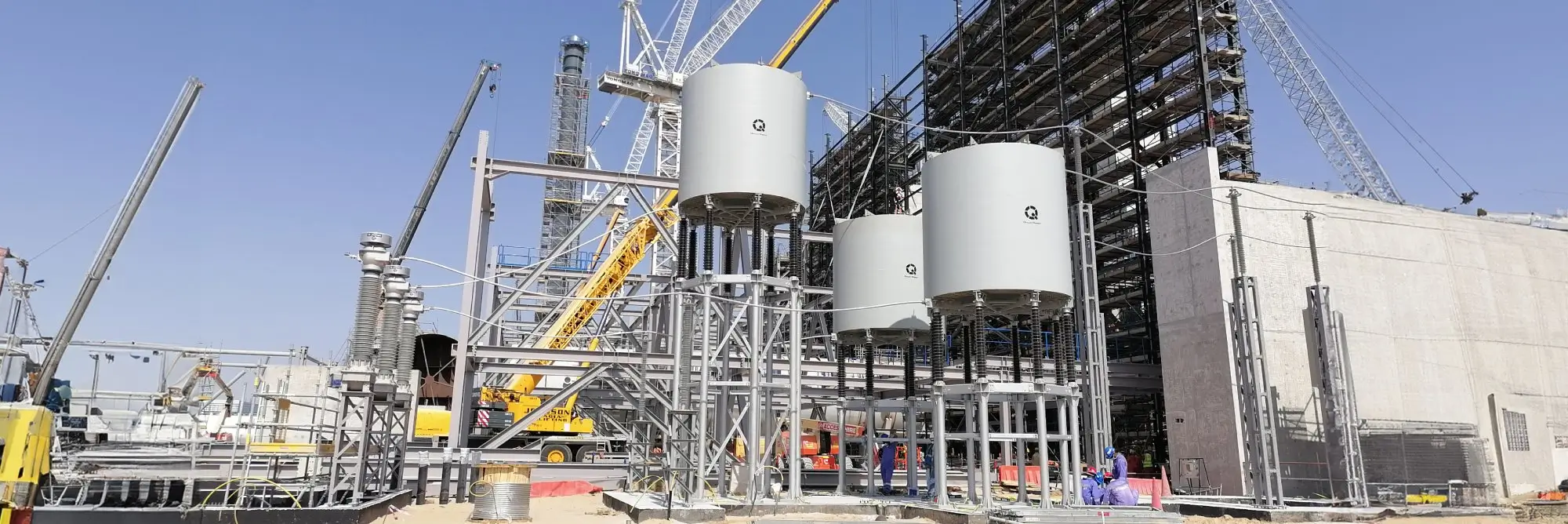
Reactors > Series Reactors
Fault current
limiting Reactor
Current Limiting Reactors (CLRs) play a critical role in managing and mitigating fault currents in power systems. These devices are installed in series with power lines and operate continuously to dampen short-circuit currents, protecting the power system infrastructure from damage and ensuring reliable operation. This detailed summary explores the design, functionality, applications, and benefits of CLRs in both utility and industrial power systems.

Design and Functionality of Current Limiting Reactors:
1 Series Connection:
- Continuous Operation: CLRs are connected in series with power system components, such as transmission or distribution lines, transformers, and switchgear. During normal operation, they carry continuous current, maintaining minimal impedance to allow efficient power flow.
- Fault Current Damping: In the event of a short circuit or fault, CLRs introduce significant inductive reactance into the circuit, which helps to limit the magnitude of the fault current. This damping effect is crucial for protecting system components and maintaining stability.
2 Reduction of Electromechanical Loading and Thermal Stress:
- Transformer and Switchgear Protection: By limiting fault currents, CLRs reduce the electromechanical forces and thermal stresses experienced by transformers and switchgear. This protection prevents mechanical damage and overheating, extending the lifespan of these critical components.
- Minimizing Wear and Tear: Continuous exposure to high fault currents can lead to significant wear and tear on system components. CLRs mitigate this by controlling the fault current, thereby reducing maintenance needs and improving system longevity.
3 Stability Improvement of Primary Bus Voltage:
- Voltage Regulation: During a fault condition, CLRs help stabilize the primary bus voltage by limiting the fault current. This stability is essential for maintaining the overall integrity of the power system, preventing voltage dips that can affect connected loads.
- Enhanced Fault Ride-Through Capability: Improved voltage stability during faults ensures that critical loads and sensitive equipment continue to operate reliably, enhancing the fault ride-through capability of the power system.
4 Reduction of Line-to-Line and Line-to-Ground Fault Currents:
- Balanced Fault Current Levels: CLRs can be designed to reduce line-to-line fault currents to levels below line-to-ground fault currents or vice versa, depending on system requirements. This balancing act helps optimize protection schemes and improves overall system safety.
- Selective Fault Mitigation: By controlling the magnitude of specific types of fault currents, CLRs enable more selective and effective fault mitigation strategies, ensuring better protection for the power system.
5 Protection from Fast Front Voltage Transients:
- Transient Suppression: CLRs protect distribution transformers and downstream power equipment from fast front voltage transients caused by faults and circuit breaker operations. These transients can propagate through the system and cause significant damage if not adequately controlled.
- Voltage Transient Mitigation: By limiting the propagation of these transients, CLRs help maintain power quality and protect sensitive equipment from voltage spikes and surges.
6 System Reliability Enhancement:
- Fault Isolation: Effective fault current limiting and transient suppression contribute to the overall reliability of the power system. CLRs help isolate faults, preventing widespread disruptions and allowing for faster recovery.
- Reduced System Stress: By managing fault currents and mitigating transients, CLRs reduce the overall stress on the power system, leading to fewer faults and outages. This reliability is critical for both utility and industrial power systems.
Applications of Current Limiting Reactors:
1 Utility Power Systems:
- Transmission and Distribution Networks: In utility power systems, CLRs are used in transmission and distribution networks to limit fault currents, protect infrastructure, and maintain voltage stability. They are particularly useful in densely interconnected grids where fault currents can reach very high levels.
- Substation Protection: CLRs are installed in substations to protect transformers, switchgear, and other critical components from fault-induced stress and damage.
2 Industrial Power Systems:
- Industrial Facilities: In industrial settings, CLRs are used to protect equipment and improve the reliability of power supply. Industrial facilities often have high power demands and complex electrical systems that can benefit significantly from the fault current limiting capabilities of CLRs.
- Critical Process Protection: CLRs help maintain the continuity of critical industrial processes by preventing voltage dips and equipment damage during faults, ensuring operational stability and productivity.
Benefits of Current Limiting Reactors:
1 Enhanced Protection:
- Component Longevity: By reducing the electromechanical and thermal stresses on transformers, vswitchgear, and other components, CLRs extend their operational life, reducing the need for frequent replacements and maintenance.
- Improved Fault Management: CLRs enhance the overall fault management strategy of the power system, ensuring that faults are effectively contained and isolated, minimizing damage and downtime.
2 Increased System Stability:
- Voltage Stability: CLRs contribute to voltage stability during fault conditions, preventing voltage dips and maintaining power quality. This stability is essential for the reliable operation of connected loads.
- Enhanced Transient Response: By suppressing fast front voltage transients, CLRs improve the transient response of the power system, protecting sensitive equipment and maintaining operational continuity.
3 Operational Efficiency:
- Reduced Maintenance Costs: With the protection provided by CLRs, maintenance costs are reduced as components experience less wear and tear and fewer failures.
- Improved Reliability: The overall reliability of the power system is improved, with fewer faults and outages, ensuring continuous and efficient operation.
4 Scalability and Flexibility:
- Adaptable Design: CLRs can be designed and scaled to meet the specific needs of various power systems, whether utility or industrial. This adaptability makes them a versatile solution for a wide range of applications.
- Future-Proofing: As power systems evolve and expand, CLRs can be integrated into new and existing infrastructure, providing ongoing protection and stability.


